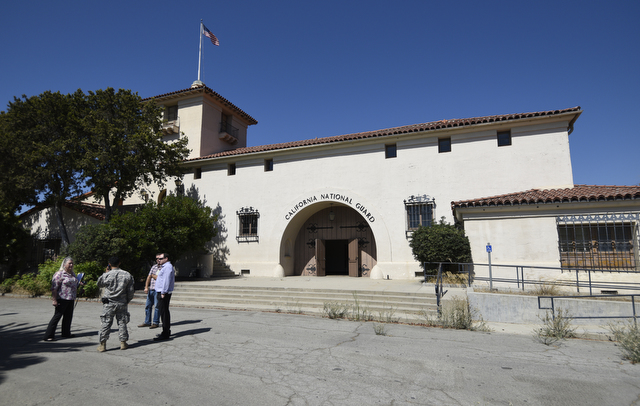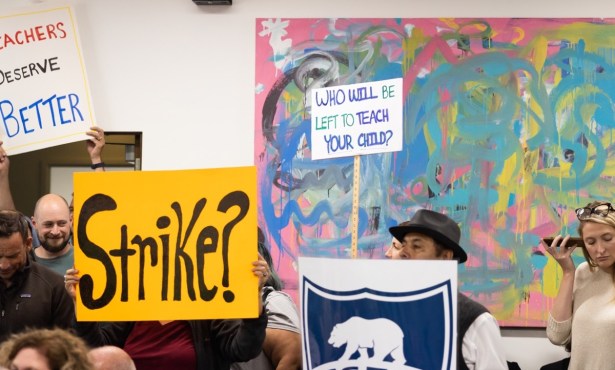School Chief Plays Poker with Sacramento Over Armory
State, Santa Barbara Can't Agree on the Property's Price Tag

In one of the biggest land deals to hit downtown in the past 30 years, Santa Barbara schools chief Cary Matsuoka has found himself playing a game of high-stakes poker with negotiators for the state’s Department of General Services. The two sides met this Tuesday in the Sacramento offices of State Assemblymember Monique Limón to hash out differences of opinion worth about $5 million.
At issue is the value of the long-abandoned CA National Guard Armory, a 4.5-acre chunk of prime real estate located between Santa Barbara Junior High and Santa Barbara High School, which happens to be owned by the State of California. The school district wants to buy it. General Services says the property’s worth $11.6 million; the district says it’s worth a lot less.
Matsuoka brought along a recent report indicating the armory buildings don’t meet modern seismic safety standards and that the land itself, having been built on the site of Santa Barbara’s old lagoon, is prone to liquefaction during earthquakes. All this, Matsuoka argued, will increase the cost of developing the land by “several million dollars.” And that, he said, should be discounted from the appraised purchase price. There was no eureka moment or breakthrough, but the state’s appraiser agreed to visit the site with officials from the school district at a later date.

Limón has an uncommonly intimate familiarity with the armory site, having attended both Santa Barbara Junior High and Santa Barbara High School. And as a former school boardmember for eight years, she’s acutely aware of efforts undertaken by the district to acquire this property. “The meeting was very positive, and hopeful,” she said afterward.
While no specific plans exist for developing the property as yet, the district has talked glowingly of its recreational and educational opportunities. Two years ago, the district made acquisition of the armory the centerpiece of a successful campaign to win voter approval for school bond measures I and J. Written into the ballot language was a commitment to spend up to $20 million to buy the armory, rehabilitate structures declared historic landmarks, and redevelop the rest.
This Tuesday’s meeting was the first time the two sides met face-to-face. “There have been lots of conversations back and forth, but this was the first time,” said Limón. “They’ve been very difficult to bargain with so far,” Matsuoka said in an interview before Tuesday’s confab.
Over the years, many school boardmembers and community activists have looked at the armory with the civic equivalent of lust. The state, however, showed no sign of parting with it. Three years ago, however, the Department of General Services quietly took steps to market the property. No one contacted the school district or either of Santa Barbara’s two representatives in Sacramento. “It looked like they were trying to sneak it by us,” stated former assemblymember Das Williams, now a county supervisor. When Williams found out, he blew the whistle and got emergency legislation passed requiring that the school district be given first right of refusal to buy the land. “I think they saw dollar signs dancing in front of them,” Williams added.
The big question is: Now what? Land appraisal is far from an exact science, and there are no comparable properties to guide future deliberations. The amount of remediation required of the property, Williams argued, should be based on how that property is used. Housing, for example, would require a far higher level of remediation than soccer fields.
Complicating matters further, the school board voted to use revenues from Measures I and J to cover the unanticipated cost increases associated with a major reconstruction of Santa Barbara High School’s iconic and historic Peabody Stadium. Initially, district bean counters estimated the stadium renovation would cost $11 million, of which the district would pay $8 million. Since then, however, the cost of rebuilding the stadium — new stands, new synthetic turf, new track, new underground storm drains, and 500 fewer seats — has mushroomed to nearly $39 million, $30 million of which the district is on the hook for.
Williams expressed concern that the stadium would drain funds that might prove necessary to make the armory project a reality. Matsuoka has insisted there’s enough money to cover the costs of both projects. Williams said he was reassured there would be enough to buy the armory property but not entirely convinced there would be enough to cover the costs of rehabilitation and redevelopment.
If that came to pass, Matsuoka expressed confidence the district could compete successfully for other state funds necessary to bring the armory project to fruition. The important thing, he said, was to acquire the property now and establish title to the land. Downtown real estate, he stressed, was not getting any cheaper or more plentiful. “While the land is not perfect,” Matsuoka said, “the location is perfect.”



